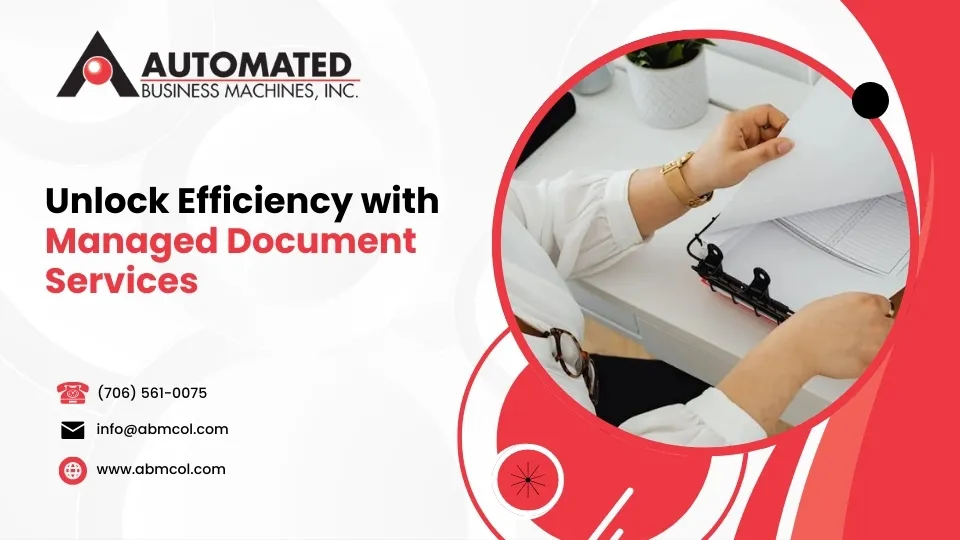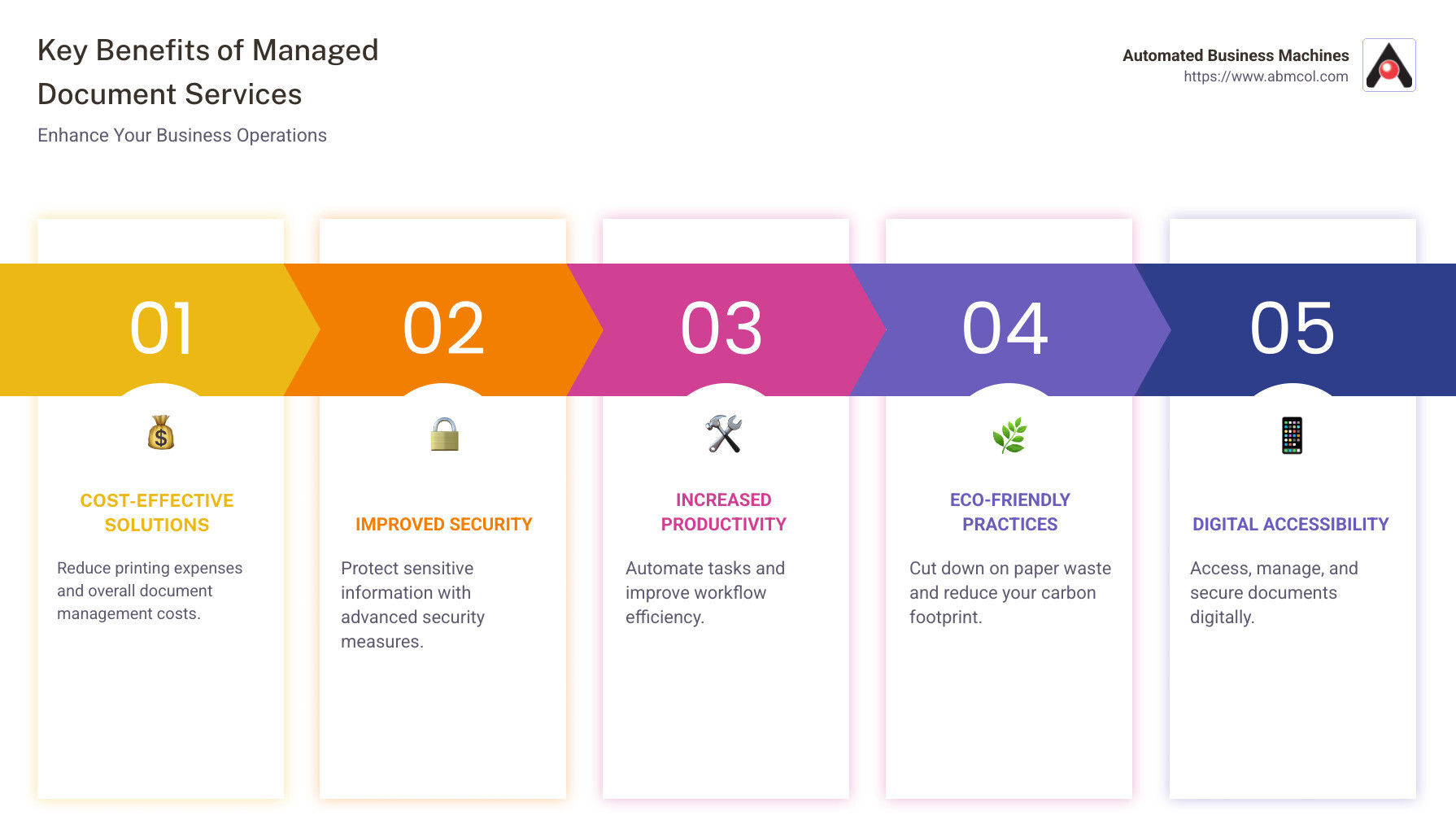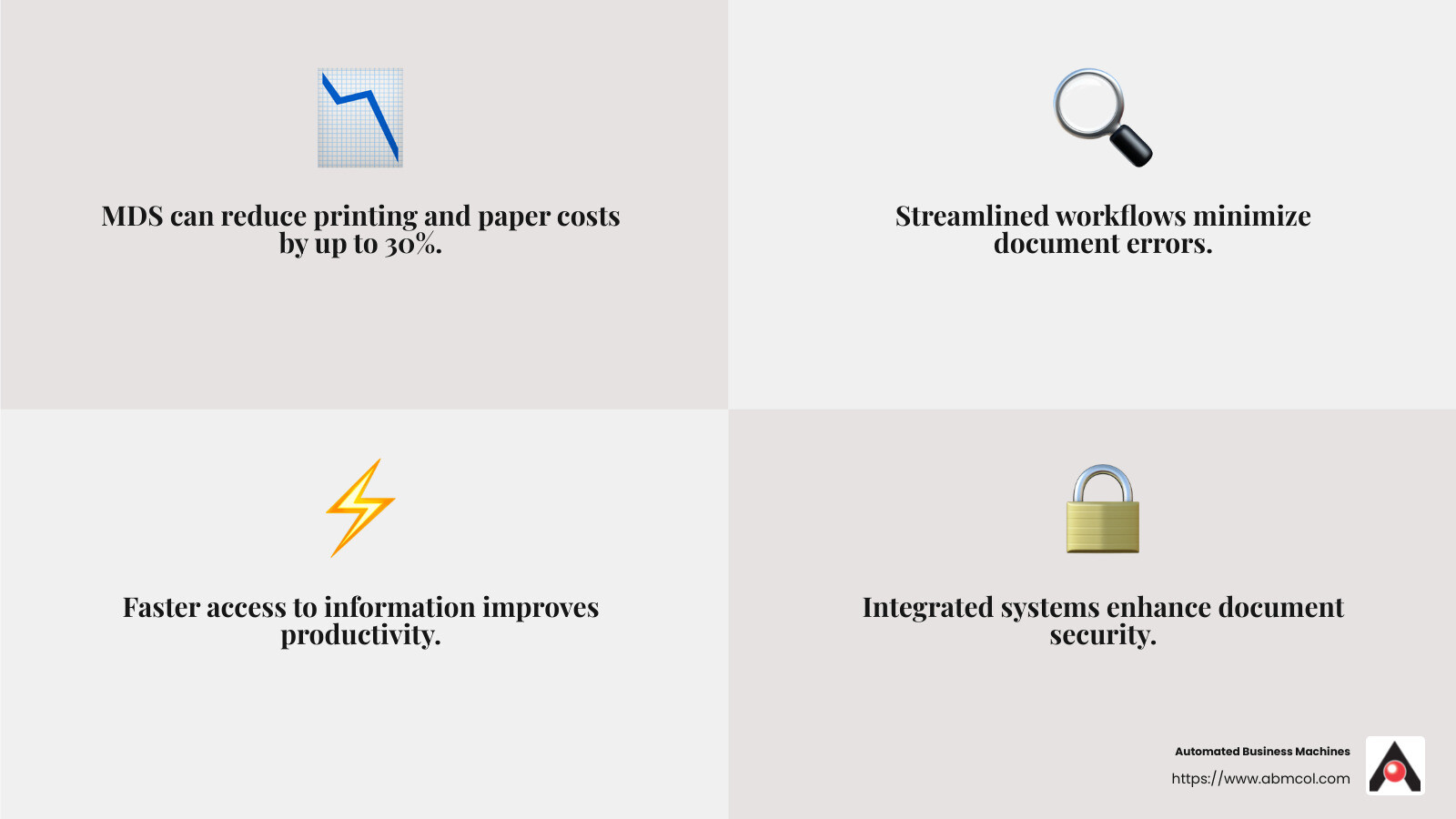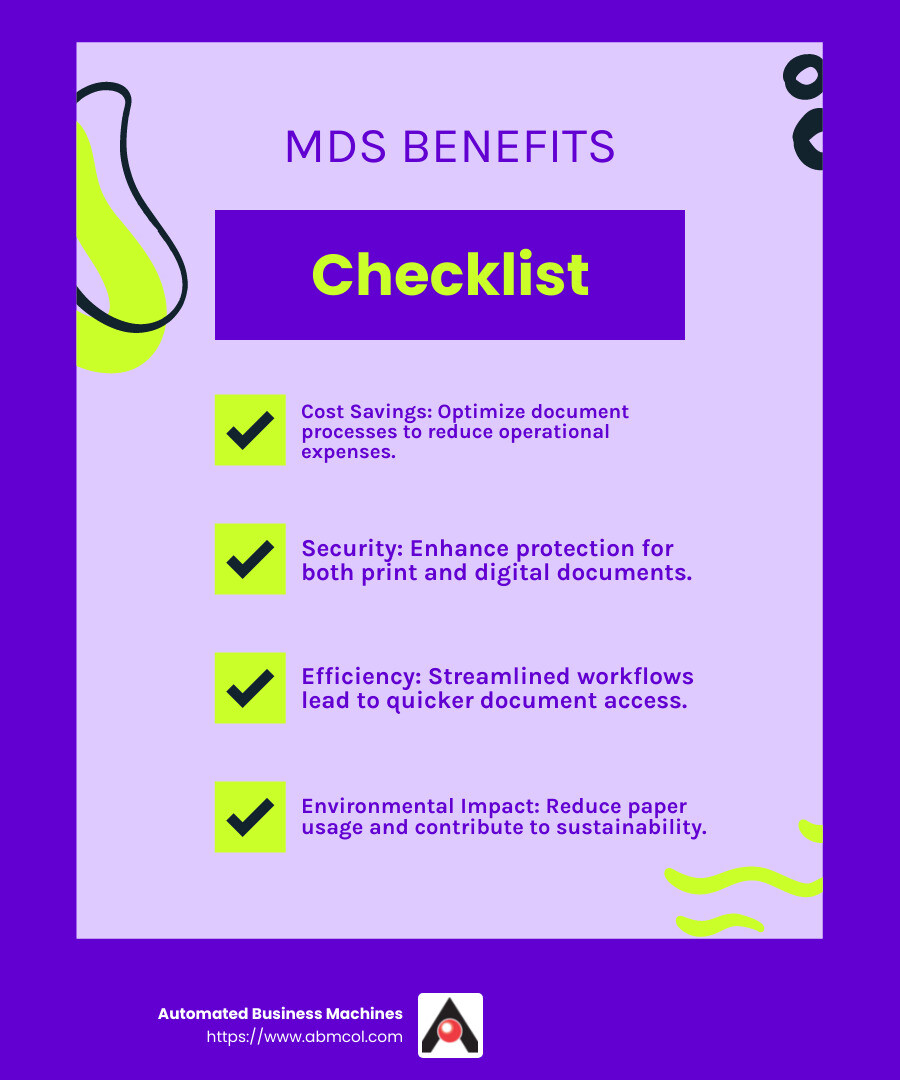
Managed document services are like having an expert team to organize and streamline both printed and electronic documents, not just manage paper chaos. By automating and optimizing document workflows, these services tackle key concerns like high operational costs, security, and productivity bottlenecks.
- Cost-Effective Solutions: Reduce printing expenses and overall document management costs.
- Improved Security: Protect sensitive information with advanced security measures.
- Increased Productivity: Automate tasks and improve workflow efficiency, freeing up time for other important activities.
- Eco-Friendly Practices: Cut down on paper waste and reduce your carbon footprint.
Today, the paperless office is not just a goal; it’s becoming a reality with tools that ensure you can access, manage, and secure your documents digitally. Managed document services offer a comprehensive strategy to handle these tasks, helping businesses like yours save time and improve efficiency while navigating the intricacies of document management.
Understanding Managed Document Services
Managed Document Services (MDS) is a comprehensive approach that optimizes your entire document infrastructure. This includes everything from capturing and storing documents to managing workflows and ensuring security. MDS isn’t just about managing paper documents; it integrates both printed and electronic documents into a seamless system.
Document Infrastructure
Think of your document infrastructure as the backbone of your business’s information flow. Without a well-organized system, documents can get lost, workflows become inefficient, and costs can skyrocket. MDS helps by creating a streamlined process that connects all aspects of document management. This means fewer errors, faster access to information, and a more organized workspace.
Cost Reduction
One of the biggest advantages of Managed Document Services is cost reduction. By optimizing your document infrastructure, you can see a reduction in printing and paper costs by up to 30%. How? By identifying wasteful practices and implementing more efficient workflows. For example, MDS highlights where time and resources are wasted and creates a tailor-made environment to reduce costs.
Beyond printing, MDS also cuts costs by reducing energy consumption and lowering service and support expenses. Implementing binding print policies can avoid unnecessary color printing, and replacing outdated devices can further streamline operations.
Real-World Impact
Let’s look at a real-world example. By using a solution that reads handwriting and forms, a company reduced operational costs and increased customer satisfaction. This shows how MDS can lead to significant improvements in both cost and service quality.
In summary, Managed Document Services offer a smart, efficient way to handle your document needs. They not only improve your document infrastructure but also lead to substantial cost savings. By streamlining processes and cutting waste, MDS helps your business run more smoothly and effectively.
Next, we’ll explore the key benefits of MDS in more detail.
Key Benefits of Managed Document Services
Managed Document Services (MDS) offer a host of benefits that can transform the way your business handles documents. Let’s explore the key advantages, including cost savings, environmental impact, security, and productivity.
Cost Savings
One of the most compelling reasons to adopt MDS is the potential for cost savings. By optimizing your document processes, MDS can reduce overall costs by up to 30%. This includes saving money on consumables like paper and toner, as well as cutting energy costs. With MDS, you can also lower service and support expenses by streamlining your print environment.
Here’s a quick breakdown of how MDS can save you money:
- Reduced Consumables: Less paper and toner usage.
- Energy Efficiency: Lower energy bills by using optimized devices.
- Service Costs: Fewer breakdowns and maintenance needs.
- Policy Implementation: Set print policies to control unnecessary printing.
Environmental Impact
MDS not only saves money but also helps reduce your company’s environmental impact. By cutting down on paper usage and energy consumption, MDS supports a more sustainable business model. Automated Business Machines’ MDS focuses on preserving resources and reducing waste, making it a smart choice for eco-conscious businesses.
Improved Security
Security is a top priority for any organization, and MDS offers robust solutions to keep your documents safe. With features like access control and audit trails, MDS ensures that sensitive information is protected. Automated Business Machines emphasizes securing not just the printer but the entire network, providing real-time threat detection and automated monitoring.
Increased Productivity
By streamlining document workflows, MDS improves productivity. Employees spend less time searching for documents and more time on tasks that matter. Automated Business Machines’ MDS aligns devices with business missions and takes care of day-to-day management, ensuring optimal uptime and efficiency.
- Faster Access: Quick retrieval of documents.
- Streamlined Workflows: Automated processes reduce manual tasks.
- Employee Focus: More time for core business activities.
In conclusion, Managed Document Services offer a myriad of benefits that go beyond simple document management. From saving costs to enhancing security and boosting productivity, MDS is a powerful tool for any organization looking to optimize its document processes.
Next, we’ll explore how Managed Document Services work in practice.
How Managed Document Services Work
Understanding how Managed Document Services (MDS) function can transform your business’s document handling. Let’s break down the process into five key stages: Assess, Design, Implement, Optimize, and Manage.
Assess
The first step in MDS is a comprehensive assessment of your current document infrastructure. This involves evaluating your fleet of devices, understanding your document workflows, and identifying areas for improvement.
- Fleet Evaluation: Analyze the devices you currently use.
- Workflow Analysis: Look at how documents move through your organization.
- Cost and Security Review: Identify potential savings and security gaps.
A thorough assessment sets a strong foundation for the next steps.
Design
After the assessment, a custom design is created for your organization. This design plan is custom to meet your specific needs and goals.
- Strategy Development: Craft a plan that aligns with your business objectives.
- Device Optimization: Choose the right devices for your needs.
- Workflow Improvement: Design processes that streamline document handling.
The design phase ensures that the MDS solution is perfectly suited to your business.
Implement
Next comes implementation, where the design plan is put into action. This involves setting up new devices, integrating them with existing systems, and training your staff.
- Device Installation: Set up and configure new hardware.
- Integration: Connect new systems with existing networks.
- Training: Educate employees on new processes and tools.
Implementation brings the design to life and gets your team on board.
Optimize
Once the system is in place, continuous optimization is key. This means regularly reviewing and adjusting processes to ensure maximum efficiency.
- Performance Monitoring: Track system performance and identify bottlenecks.
- Process Refinement: Make necessary tweaks to improve workflows.
- Feedback Loop: Gather input from users to improve the system.
Optimization helps keep your document management system running smoothly and efficiently.
Manage
The final stage involves ongoing management of your document services. This includes regular maintenance, updates, and support to ensure everything runs smoothly.
- Proactive Maintenance: Regular check-ups to prevent issues.
- System Updates: Keep software and hardware up to date.
- User Support: Provide assistance to resolve any issues quickly.
Effective management ensures long-term success and reliability of your MDS solution.
By understanding and implementing these stages, businesses can open up significant efficiencies in document management, driving both productivity and cost savings.
Next, we’ll tackle some frequently asked questions about Managed Document Services to further clarify how they can benefit your organization.
Frequently Asked Questions about Managed Document Services
What are Managed Document Services?
Managed Document Services (MDS) involve the outsourcing of document management tasks to improve both the print and electronic document workflow of an organization. MDS goes beyond just managing printed documents; it covers the entire document infrastructure, including electronic documents. By optimizing these processes, businesses can reduce costs, improve security, and simplify their document handling systems.
How do Managed Document Services improve efficiency?
MDS improves efficiency through workflow optimization and document control. By streamlining how documents are created, shared, and stored, MDS minimizes bottlenecks and reduces the time spent searching for information. With the right MDS strategy, businesses can automate repetitive tasks, ensure documents are easily accessible, and maintain a secure and organized document environment.
- Workflow Optimization: Automates and refines document processes to save time.
- Document Control: Ensures that only authorized personnel can access sensitive information.
What is the difference between Managed Document Services and Document Management?
While both Managed Document Services and Document Management deal with handling documents, they serve different purposes.
- Managed Document Services focus on optimizing the entire document infrastructure, which includes both print and electronic formats. MDS is about improving the efficiency and security of document workflows and reducing overall costs.
- Document Management, on the other hand, is specifically about the storage, retrieval, and control of electronic documents. It ensures that digital files are organized, secure, and easily accessible. Document management systems often include features like version control, indexing, and audit trails.
In contrast, Content Management systems manage the creation, modification, and delivery of digital content, which can include documents, but also extends to other content types like videos and web pages.
By understanding these differences, businesses can choose the right solutions to meet their specific needs and improve their document-related processes.
Next, let’s explore how Automated Business Machines can offer customized solutions to meet your business’s unique needs.
Conclusion
At Automated Business Machines, we understand that every business is unique. That’s why we offer customized solutions tailored to your specific needs. Whether you’re looking to improve productivity, secure your documents, or streamline your workflow, our managed document services have you covered.
Our expertise in secure printing ensures that your documents are protected at every stage. From the moment a document is created to when it’s printed or archived, we implement robust security measures. This means you can trust that sensitive information stays confidential and only authorized personnel have access.
By partnering with us, you’ll benefit from advanced technology solutions designed to improve productivity and workflow. Our locally owned and operated company takes pride in serving businesses across Georgia, including locations in Albany, Atlanta, and Savannah, among others.
Ready to open up efficiency with managed document services? Find out how our Managed Print Solutions can transform your business today.



